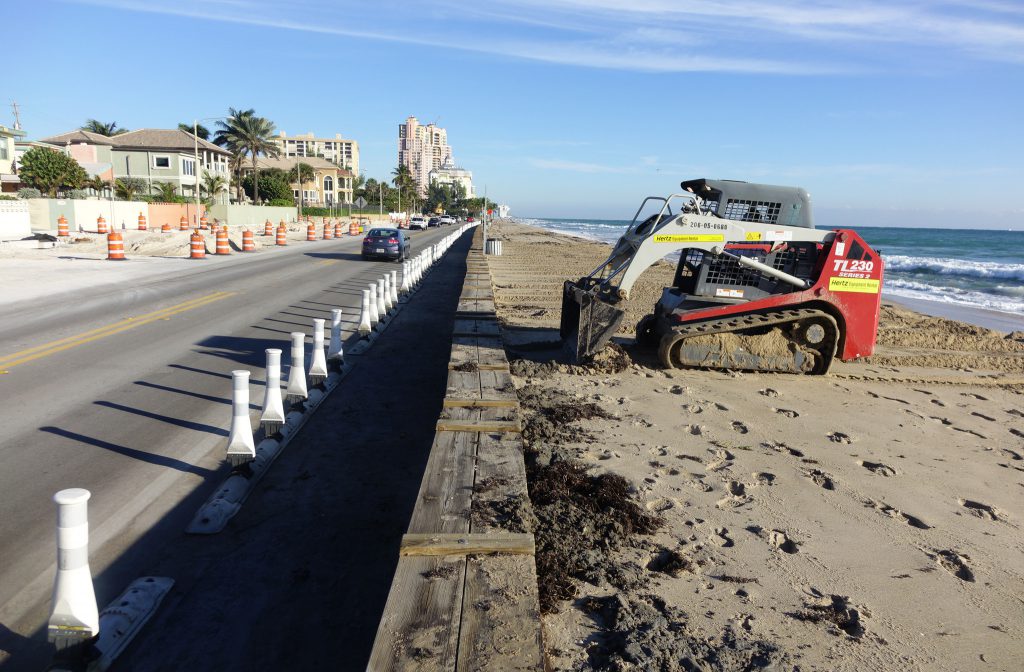
Since 2015, BRS has been working with a project team of New Jersey Future and Princeton Hydro to implement the Sustainable and Resilient Coastal Communities planning program in the towns of Little Egg Harbor, Tuckerton and Toms River in Ocean County, New Jersey. The purpose of this project is to develop a comprehensive land use planning strategy that explicitly considers the risks of coastal hazards and projected sea-level rise, in order to achieve resilient community design.
According to a 2014 Rutgers University working brief for the New Jersey Climate Adaptation Alliance, New Jersey coastal communities have found themselves paying to reconstruct public infrastructure, such as roads, seawalls, bridges and parks, as a result of hurricanes, tropical storms, and associated storm surges. With climate change rendering more areas vulnerable to sea level rise and extreme storm events, public infrastructure continues to be and costs to repair them are likely to increase.
For this reason, a recurring question throughout this project has been: what is a municipality’s legal responsibility to maintain infrastructure in high-risk areas? That is, can a municipality legally withhold infrastructure investment in selected areas, or must they continue to maintain infrastructure in areas impacted by sea level rise and extreme storm events.
According to a November 2007 paper from the Association of State Floodplain Managers, all levels of government may be sued for negligence, nuisance, breach of contract, or the “taking” of private property without payment of just compensation under certain circumstances when they increase flood or erosion hazards. In fact, local governments may be the most vulnerable to liability suits based on increasing natural hazards due to climate change because they are usually the unit of government responsible for the active management of hazardous lands, for example, road building and maintenance; operation of public buildings such as schools, libraries, town halls, sewer and water plants; parks). (Kusler and Thomas).
Case law from around the country supports this assessment of municipal responsibility and helps us to understand how the Courts have interpreted this issue, depending on the individual circumstances.
Courts have repeatedly held that once a governmental unit elects to undertake government activities, even where no affirmative duty exists for such action, it must exercise reasonable care. Indian Towing v. United States, 350 U.S. 61 (1955): “A governmental entity’s decision not to build or modernize a particular improvement is a discretionary judgmental function with which we have held that the courts cannot interfere.”
Municipalities are not required to upgrade infrastructure, but they must “maintain” it, even if it costs more to do so. For example, “if a sewer is adequate when constructed the municipality is not liable because of subsequent inadequacy occasioned by the growth of the municipality and the increased demands made upon the sewer.” In Ecological Development, Inc. v. Walton County, 558 So.2d 1069, 1071 (Fla. 1st DCA 1990), the Court held that a county is not obligated, nor can it be compelled, to perform or provide for any particular level of maintenance, except as it voluntarily assumes to do.”
Another case for supporting municipal responsibility for maintaining existing infrastructure is furthered by Jordan v. St. Johns County, 63 So. 3d 835, which was decided by a Florida District Court of Appeals in 2011. In this case, the appellants all owned property on a barrier island, with the only vehicle access provided by a county-owned road known as Old A1A. This 1.6–mile stretch of road is bordered on the east by the Atlantic Ocean and on the west by the Intracoastal Waterway, and is subject to repeated damage from natural forces such as storms and erosion. A group of property owners filed suit against St. John’s County, seeking relief for what they viewed as the County’s intentional failure to maintain the road in useable condition.
The Court ruled in the property owners’ favor on two counts, Count I, which was for declaratory relief and determined the County had a duty to maintain the road, and Count III, which claimed inverse condemnation for the diminished access to the properties: The Court held that the County has a duty to reasonably maintain Old A1A as long as it is a public road dedicated to the public use. The County must provide a reasonable level of maintenance that affords meaningful access, unless or until the County formally abandons the road. The Court also held that the property owners had a right to be compensated through inverse condemnation when governmental action causes a substantial loss of access to one’s property even though there is no physical appropriation of the property itself.
Some courts have also held that governments are “strictly liable” for the collapse of dams and other water control structures such as levees because the activity of impounding water is an inherently hazardous activity. Therefore, public landowners are liable for damages from such hazardous activities even when no negligence is involved.
Additionally, all individuals, including public employees, have a duty to act “reasonably” so as not to cause damage to other members of society. According to Guilbeau v. Liberty Mutual Insurance Company, 338 So.2d 600 (La.1976): “Actionable negligence results from the creation or maintenance of an unreasonable risk of injury to others. Not only is the seriousness of the harm that may be caused relevant in determining whether a risk is unreasonable, but also the likelihood that harm may be caused.” The standard of conduct is that of a “reasonable person” in the circumstances. Negligence is the primary legal basis for public liability for improper design of hazard reduction measures, which may include flood control structures, improperly prepared and issued hazard warnings, inadequate inspections and processing of permits.
BRS, Inc. is not a law firm. Nothing contained herein should be interpreted as legal advice nor should it be relied upon in any legal context. Contact an attorney for guidance on these matters.


